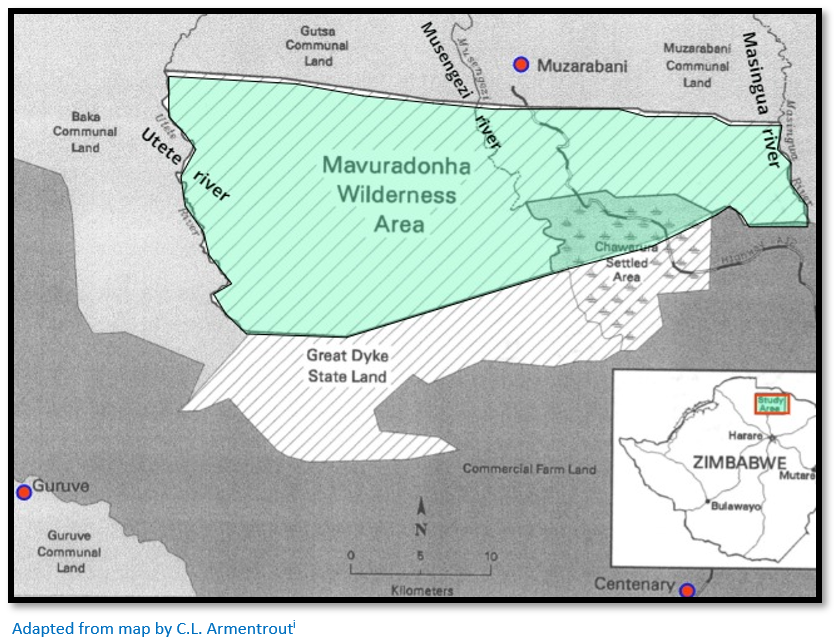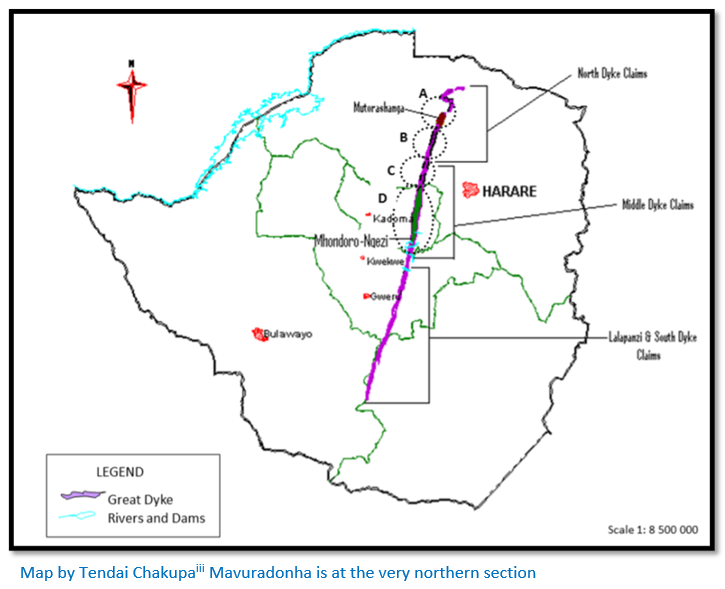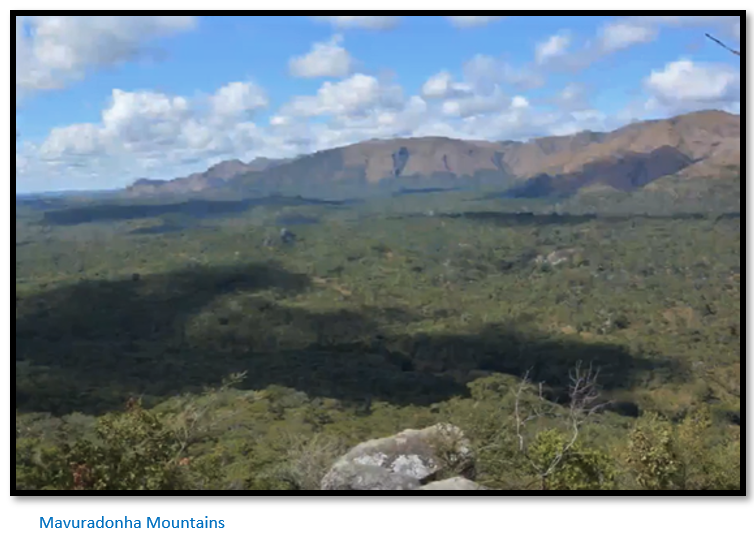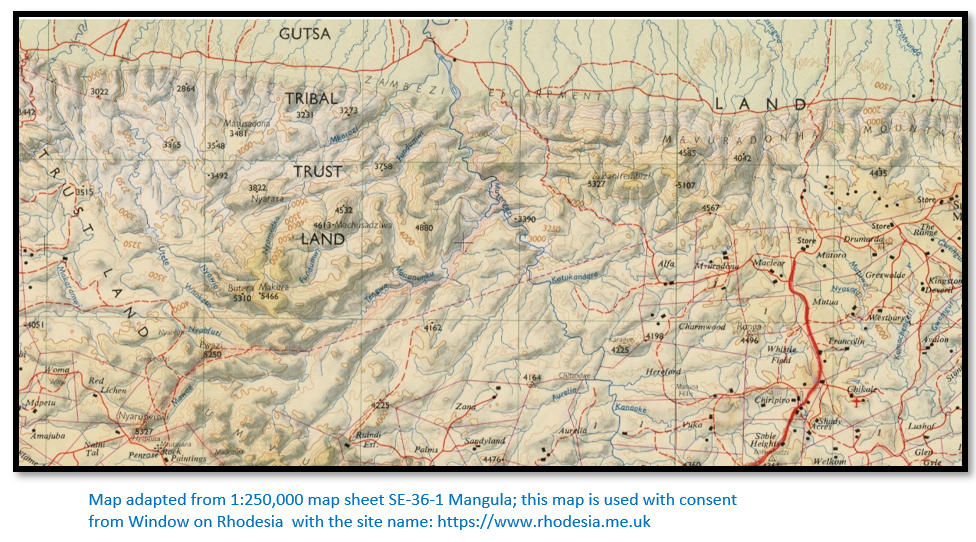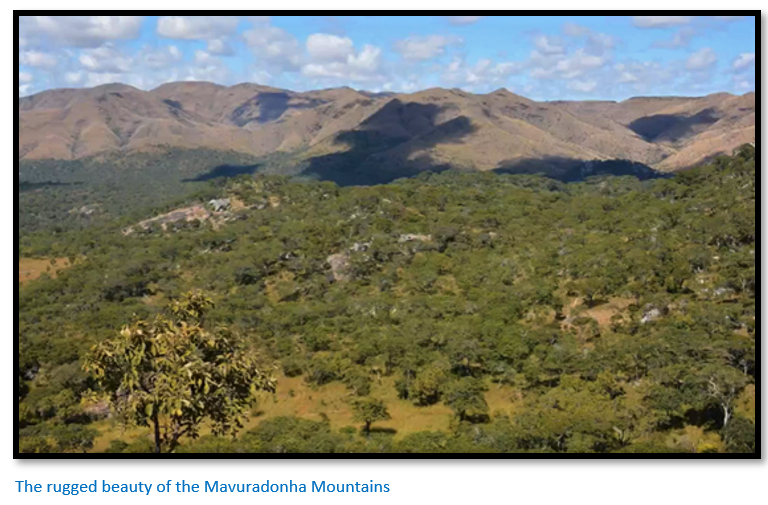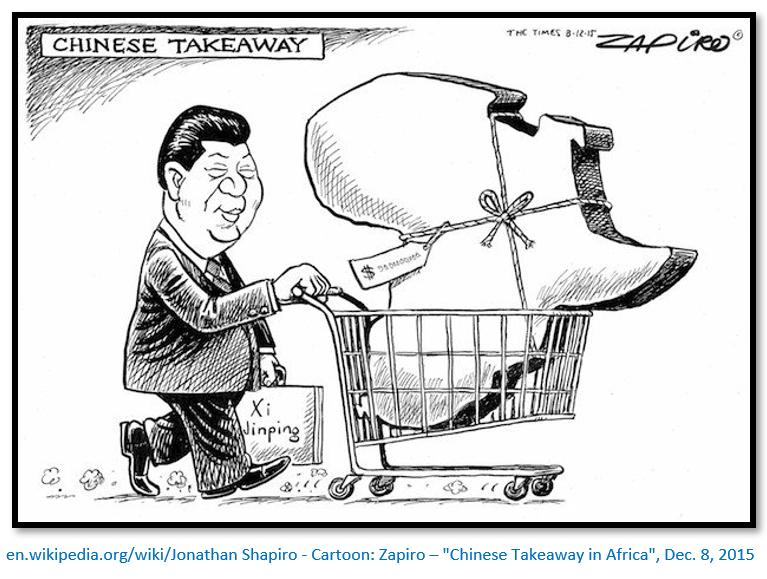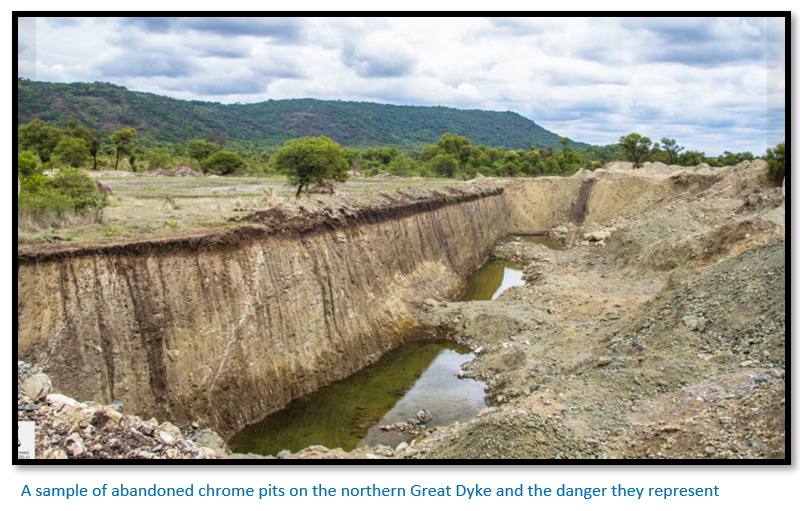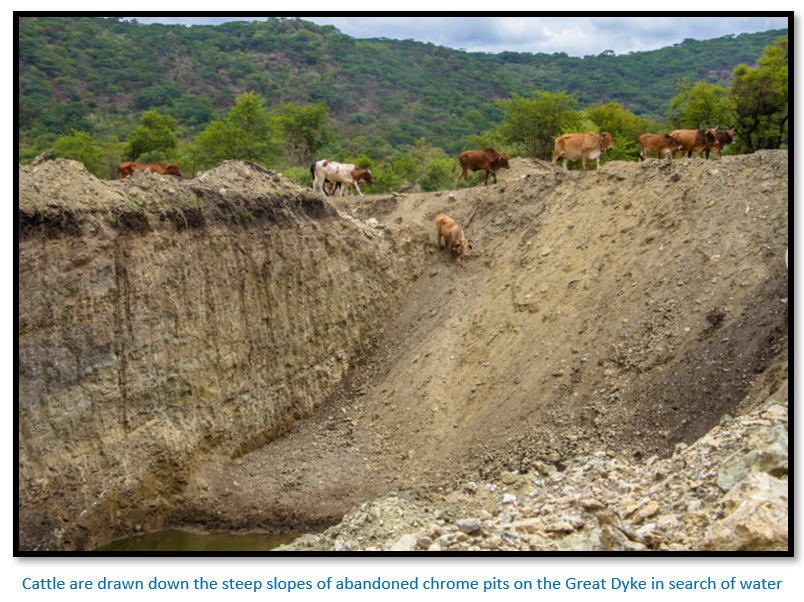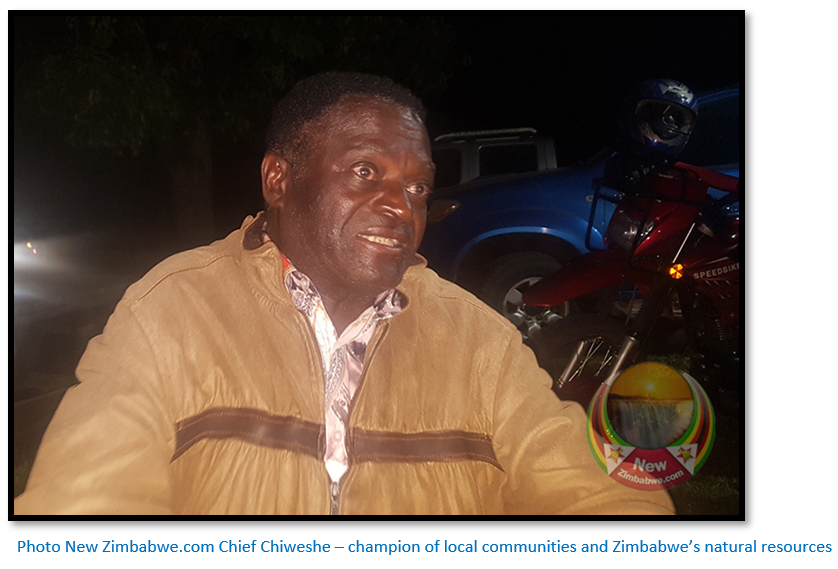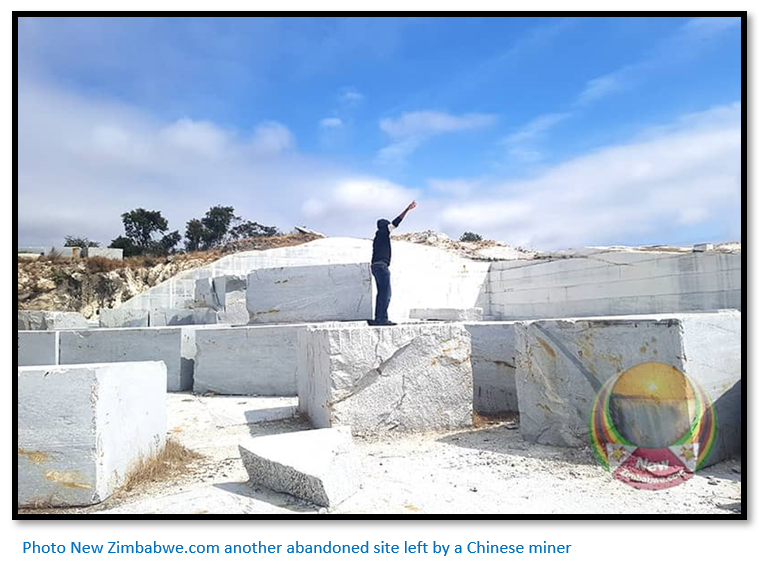Home >
Mashonaland Central >
Chinese mining companies are causing turmoil in the Mavuradonha Wilderness Area
Chinese mining companies are causing turmoil in the Mavuradonha Wilderness Area
Where is the Mavuradonha Wilderness Area?
Ask most Zimbabweans if they ever heard of the Mavuradonha Wilderness Area (MVA) and the answer is most likely to be “Huh…do you mean Matusadona? I think that’s on the Zimbabwe side of Lake Kariba, isn’t it?” The Mavuradonha Mountains are little-known and so to give you some clues I have included the map below. You will notice that they are at the very northern tip of the mineral-rich Great Dyke – that massive geological resource feature that runs from north to south through the centre of Zimbabwe. In addition to the Mavuradonha Mountains, the Wilderness Area includes the Malingura Hills, the Mvukwes Range and the Rwazi Plateau as well as part of the Zambesi escarpment. To the north of the MWA is Muzarabani, to the south-west Guruve (formerly Sipolilo) and to the south Centenary.
The Mavuradonha Wilderness area forms a buffer zone between the Muzarabani Communal lands to the north and the Centenary commercial farming area to the south.
Why is the area important to foreign investors?
Have a look again at the map above…the area just to the south of the area coloured in as Mavuradonha Wilderness Area is labelled as ‘Great Dyke State Land’ and that tells you quite a lot. Here, the Zambesi escarpment meets the northern range of Zimbabwe’s mineral-rich Great Dyke, resulting in a complex geological mountain fusion rising over 1,000 metres with the highest peak of Mount Banirembizi in the east.
Zimbabwe has the second largest chrome deposits (19%) in the world after South Africa[ii] with almost all the mining taking place along the Great Dyke, a mountain range that runs for 550 km up the length of Zimbabwe and is rich in ferrochrome, platinum and gold deposits. Significantly Zimbabwe’s chrome ore is much higher grade than anywhere else.
Chrome has been mined since the early 20th Century; mining has been carried out in the past by Union Carbide Corporation and Rio Tinto, but the major player since independence was Zimasco which became subject to endless political meddling and intrigues under President Mugabe and has been owned since 2007 by Sinosteel.
Why is the Mavuradonha Wilderness Area important to local communities?
The area was given protected status as a game reserve and Wilderness Area in 1987 - the first such designation within Communal Land. It is administered by the community through the Muzarabani District Council in conjunction with the Wildlife Society which leases out tourism concessions within its boundaries with revenues accruing to the Council through a project CAMPFIRE arrangement.
The area was declared a National Monument in January 2017 because of its historical and cultural importance and covers 575 km² with the Zambesi escarpment as its northern border which meets the northern range of the Great Dyke resulting in a tumbled mass of peaks and sharp ridges. It is an area of true wilderness and seldom visited, even by local people.
The Shona name “Mavuradonha” roughly translates as ‘Land of Falling Water’ or simply ‘water falls.’ The Mavuradonha mountains lie in the path of the north-east winds and the ensuing rains brings a cooler, moister climate than in the Zambesi Valley below with misty clouds often seen over the mountain tops. The landscape is extremely wild and rugged, with heavily-wooded granite outcrops alternating with bare grass-covered slopes. Many streams and rivers have their sources in these mountains before flowing north over the Zambesi escarpment, sometimes cutting steep waterfalls into the slopes which are mixed with old elephant trails. The Musengezi river has cut a steep-sided gorge as it heads north through the Mavuradonha mountains.
The wilderness area has been divided into two sections; the rugged western part has a safari lodge called Kopje Tops that caters for horse-riding, photography, birding and walking safaris where tourists and locals are guided by local scouts very familiar with the area. The area is a breeding ground for impala, kudu, zebra and wildebeest as well as leopards which are quite common, although rarely seen. Elephant and lion very occasionally pass through the area. The limited poaching has resulted in the area becoming a safe haven for wildlife with their numbers steadily increasing.
To the east the Mavuradonha Wilderness Eco-Lodge offers basic chalets and camping facilities and is set off the tarred road from Centenary going towards the Zambesi escarpment. Trails offer good walking and hiking from the campsite into the nearby Musengezi river gorge with fine views into the Zambesi Valley.
Cultural importance of the Mavuradonha Wilderness Area
The area is a national heritage site and has featured already in one article on this website - that of The 1561 martyrdom of Dom Gonçalo da Silveira, S.J. under Mashonaland Central on the website www.zimfieldguide.com Silveira walked from Tete following the Mazowe river and crossing the northern plateau of Mashonaland to the Massapa feira and then followed the headwaters of the Musengezi river and reached the kraal of the sixteen year old Mutapa, Chisamharu Negomo on 26 December 1560.
Within a few weeks both Chisamharu Negomo, his mother and most of his court had converted to Christianity. But very soon the Mutapa was persuaded he had made a terrible mistake and on 15 March 1651 Silveira was seized as he slept, strangled and his body thrown into the Musengezi river.
Additionally the area has a close association with the early stages of the Mutapa state – a series of articles is currently being written on this subject by this website, Nyatsimba Mutota’s burial site is within the area which also has good San rock art and there are sacred site and features associated with local traditions. A museum of cultural history is being planned for the area because of its cultural significance with funding being sought for its creation.
Mavuradonha Wilderness Area as a tourist attraction
The following is taken from the Reach Africa Birding and Getaways website, one of a number of tourist operators that offer trips into areas supporting local businesses and providing employment for the local community.
There is a great deal of well-developed miombo woodland, with most of the representative species of Brachystegia and Julbernardia. There are also gully, ravine or ‘kloof’ woodlands, with higher soil moisture and nutrients, providing a greater range of microhabitats. Large forest trees such as Khaya anthotheca occur but are scattered and in small numbers. There are also several endemic aloes and other plant species unique to the Great Dyke soils. There is a Raffia palm botanical reserve near the Kopje Tops camp.
It is a rugged place but very beautiful, with a few bush tracks to access some areas. There are several walking trails in the area leading to some very beautiful and interestingly named places, such as Bat Caves, named after the colony of Egyptian Fruit Bats roosting there, Otters Pool and Elephant Gorge. Scouts are on hand to lead visitors on foot to these places.
The Mavuradonha is an Important Bird Area (IBA), with some 290 species of birds including several large eagles. African Crowned Eagle, Verreaux’s Eagle, Ayre’s Hawk-Eagle, African Cuckoo Hawk, African Broadbill, Mountain Wagtail, Boulder Chat, Cabanis’s Bunting, Whyte’s Barbet, White-breasted Cuckoo shrike, Miombo Rock-Thrush, Wood Pipit, Flappet Lark, Grey Penduline-Tit, Miombo Double-collared Sunbird, Lazy Cisticola, Sterling’s Wren-Warbler, Black Saw-wing.[iv]
Until quite recently the area was relatively well-protected by its sheer remoteness, but local people have noted with alarm in recent years the encroaching mining activities along with felling of timber and increased wildlife poaching…all made easier by the construction of gravel roads giving increased access to the area. When the Matusadonha Wilderness Area was given National Monument status it was thought the enhanced legal protection would assist in protecting this magnificent wilderness.
George Seremwe who manages the Mavuradonha Wilderness Area said water supplies for animals in the conservancy had already been affected by the chrome mining and it was no longer flowing in the rivers. “Fortunately for villagers, they can still survive on underground water but if mining continues then that will be the beginning of serious water challenges.”[v]
No consultation with local communities
Local business sources said that Afrochine’s activities: “had been shrouded in secrecy. Construction of a four-star lodge has been put on hold because it is right where the Environmental Management Agency (EMA) has given Afrochine the right to mine. EMA seems to have not been bothered to speak to us for an opinion, having invested in Mavuradonha for nine years, but instead, the Chinese miners get their full ear and attention. Even the Mining ministry, how could it give mining rights in a national monument, which is due to become a world heritage site?"
Local people added their voices. Samson Nekatira, who lives in Guruve said: “the villagers stood a chance of benefiting from tourism receipts if the area had been developed, but the mining project had dashed their hopes. We are not going to get anything from this mining company. It's just here to exhaust our resources and go. To show you that as villagers in Guruve we are not benefiting, everything was done without our input. We were only surprised to see heavy machinery coming here."
Nekatira added: "We want this company's operations stopped and those of other companies operating in the wilderness. Police should also clamp down on illegal mining and poaching, which is happening there."[vi]
Local communities state illegal chrome mining means both they and the Mavuradonha Wilderness Area are under threat
Muzarabani villagers that surround the area have pleaded with the Government to stop illegal chrome mining activities as it is now affecting the water supply and endangering their livestock. In addition they say mining threatens the area’s status as a national heritage site.
The Zimbabwe Situation quoted Mrs Fiona Kwaramba who said the rampant illegal mining activities in the area was threating both their lives and that of the Mavuradonha Wilderness Area: “We are losing a lot of livestock due to these mining activities as the miners leave open pits. Our water sources are also being polluted…Government should assist us save the Wilderness which is part of us. It’s a tourism site which we cherish a lot. There are special species of animals as leopards, but with the current mining activities, we fear they may become extinct.”[vii]
In an interview with H-Metro, Lucia Mabambe, pleaded with the Government to intervene:
“The wilderness is endowed with historical artefacts and wild animals dear to us the local community. We have seen attempts by miners who disregard the sacredness of this area. They just come here and dig pits without even consulting us and our animals are falling and dying. We appeal to the Government to come to our rescue as it is the one that regards national heritage in high esteem. Kune zvinoera kuno and we have seen people disappear because they do what they please in our sacred mountains,” she said.
Another resident, Sekuru Mandeya told H-Metro: “We have seen people dying and disappearing in this area just because they want minerals. White people come here for sightseeing, and this helps the community and Zimbabwe at large.”[viii]
Zimbabwe government agencies are responding to local communities
Government agencies including the Ministry of Mines, Environmental Management Agency (EMA) National Museums and Monuments of Zimbabwe (NMMZ) and the Muzarabani and Guruve Rural District Councils (RDC’s) were summoned to a meeting chaired by the Local Government Minister July Moyo in Harare to discuss the situation.
Those present made the correct decision: the Chinese firm Afrochine, was told to immediately stop all mining activities within the Mavuradonha Wilderness Area (MWA) A source who attended the meeting reported that all agencies present condemned Afrochine’s irresponsible mining operations within the MWA and stated: “There appeared to be consensus that the mining is not doing any good to the conservation of our natural resources in the Mavuradonha Wilderness…It was established that some of the miners had papers but actually breached conditions set. Some had no papers at all but claimed to have authority to operate in the conservancy while others had authority from Guruve RDC but encroached into Muzarabani."
Widespread praise for Chief Chiweshe who led the protests
Chief Chiweshe has received much praise for standing up for local communities and people against irresponsible mining activities by Chinese operators and for taking a stand against Afrochine’s chrome exploration and extraction within the Mavuradonha Wildlife Area.
For too long these irresponsible activities along the whole of the Great Dyke by Afrochine and other Chinese operators have been ignored by the responsible authorities who are often powerless to stand up to them because of their strong ties to senior ZANU-PF politicians and government officials.
The source said after the crisis meeting: "The NMMZ said the area is a national monument and it is a criminal offence to alter material and cultural heritage of the area. EMA was actually saying it depends on what stakeholders are voicing in issuance of EIA certificates, if people turn them down then EMA has no right to proceed with issuing a certificate. It also raised points to the effect Mavuradonha was already being considered for global recognition by making it a World Heritage site hence any such activity might jeopardise this…
Only the Guruve RDC supported mining activities in the area although it was noted they were least affected, and the Ministry of Local Government made it clear licensing mining in areas such as Mavuradonha without its approval was illegal. It was agreed that all mining activities are suspended pending a decision made by a higher authority."[ix]
However Chief Chiweshe who put his head over the parapet in support of the local community and first voiced displeasure at Afrochine’s activities received the greatest praise for drawing the authorities attention to the problem. It was he who first alerted journalists to the deep gashes being left by Afrochine’s activities that are a danger not only to animals but to local people as well.
Chief Chiweshe told journalists his conscience forced him to reveal these threats to the environment, domestic animals and people as he said these Chinese mining operators: “were neither respecting local traditions or laws governing mining, not just at Mavuradonha Wilderness Area, but across the country.” Chief Chiweshe accused government officials of being bribed to ensure Afrochine gets approval to mine in Mavuradonha Wilderness and added: "The challenge is corruption where everyone is now aiming to get a 5 percent kickback from every investor, here we call it hukopokopo."
These are brave words indeed from a courageous Chief Chiweshe.
Chief Chiweshe told New Zimbabwe.com journalists that Afrochine and other mining companies acted with impunity – through their local proxy Allen Mashumba they had bulldozed gravel roads within the Mavuradonha Wilderness Area to transport their equipment and the mined ore and were even now constructing more access roads.[x]
In an example of wanton vandalism, another Chinese company nearby has quarried out hundreds of white granite blocks before disappearing with many of the blocks still on site and leaving a scarred mountainside and abandoned cabins which had been used by their workers. No attempt had been made to rehabilitate the mining site.
Afrochine response to accusations of environmental vandalism
The company had sent representatives to the meeting chaired by Local Government Minister July Moyo but failed to impress the agencies present.
In the usual fashion that we are accustomed to they came out guns blazing angrily and issued a statement that “for the umpteenth time” they rejected environmentalist charges that the company was operating in a protected area and stated it was all part of a coordinated media campaign that is “smearing” the company’s reputation. It rejected accusations that it was illegally operating in the Mavuradonha Wilderness Area.
However according to the Facebook article on 263Chat the High Court gave an order on 1 July 2021, barring the Chinese mining company Afrochine Smelting and Lebanon Investments from extracting chrome in Mavuradonha Wilderness Area, but despite the court order, the Chinese company continues to mine chrome in the area.[xi]
Afrochine have previous form in Zimbabwe for environmental vandalism. In 2020 only a massive public outcry prevented the mining company in partnership with Zhongxin Coal Mining Group from land clearing, road building, geological surveys and exploration drilling at two proposed sites along the road to Sinamatella Camp within the Hwange National Park, the crown jewel of Zimparks national treasures.[xii] See the article Zimbabwe Government makes the correct call and bans coal exploration within Hwange National Park under Matabeleland North on the website www.zimfieldguide.com
However Afrochine cannot deny the evidence that is visible to all
Here below is another photo posted by 263Chat and their journalist Rumbidzai Takawira. 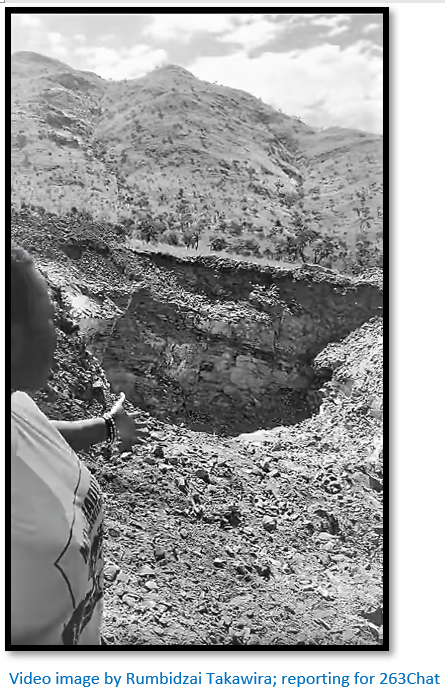
Comments from other governmental agencies
The Environmental Management Agency (EMA) has been subject to local criticism for failing to consult with local communities and giving the Chinese miners their full attention. Amkela Sidange, the EMA public relations manager, said the agency was not to blame for the developments in Mavuradonha with a statement: "Regulation of mining issues is not an EMA issue alone, it is very much multi-sectoral…EMA takes over the baton for the end of line regulation procedure of the environment impact assessment (EIA) process. Despite being at the end of the line, it remains critical and a game changer in ensuring the proposed project is done in a sustainable manner, prioritising among other key issues conclusive stakeholder consultation, which goes on to form as major key requisite in the granting of the EIA certificate, meaning the review of the EIA document submitted by the project proponent to the agency pays due diligence to the conclusivity of stakeholder consultation. An EIA is a rigorous process that follows laid-down procedures."[xiii]
All of which sounds like an attempt to switch the blame to some other agency.
In the same article by Richard Muponde in the Zimbabwe Standard, Cosmos Chiringa, Mashonaland Central provincial development co-ordinator, referred questions to the Mines Ministry stating: "Mining rights or authorisations are given by the Minister of Mines and Mining Development. I want to refer you to the provincial mining director, who is better placed to respond to your questions. But as a province, there has been different stakeholders holding meetings to determine the boundary dispute between Guruve and Muzarabani districts in our efforts to ensure mining is done within the law and peacefully."
In my day this was called ‘passing the buck.’
Mines minister Winston Chitando was not reachable for a comment. Rather a predictable response by the Minister when confronted with ‘a hot potato!’
Final Comment
The ZANU-PF government has a poor record of protecting Zimbabwe’s natural resources by the “new imperialists” who come from the East bent on looting the country’s mineral resources. With its policies designed to benefit the country’s elites in the ruling party, the military and the civil service at the expense of its ordinary citizens the country lacks sound policies and has a poor economic record. Chief Chiweshe blamed Chinese nationals for operating like the notorious gold panners known as MaShurugwi - those gangs that attacked artisanal miners and took over their claims and are believed to have the tacit support of influential politicians. In addition he said they are known for not respecting the country’s laws and traditions and not paying taxes.
Thanks to the courage of local communities and the inspired leadership of individuals like Chief Chiweshe areas such as Mavuradonha Wilderness Area can hope for some protection from these vandals who simply come and then go, and ordinary citizens are left in hope for a better Zimbabwe.
References and Notes
[i] C. L. Armentrout. Estimating the Impacts of Community Use of the Mavuradonha Wilderness Area in Zimbabwe. Oregon State University.
[ii] Martin Chitohwa. 23 March 2020. The Chrome Mining Sector Dilemma. https://miningzimbabwe.com/the-chrome-mining-sector-dilemma/
[iii] Tendai Chakupa. December 2011. Environmental Management in Chrome Mining along the Great Dyke: A case study of Zimasco Operations
[v] By Leopold Munhende. 25 July 2021. Chinese In Massive Looting Of Zimbabwe’s Minerals: Chief Chiweshe. Zimbabwe Standard
[vi] Richard Muponde. 27 June 2021. Zimbabwe Standard: Zimbabwe: Outrage Over Chinese Mining Project in Resort
[viii] Desmond Munemo. 27 July 2021. Save Mavuradonha. H-Metro.
[ix] Sources are quoted from the article by New Zimbabwe (London) by Leopold Munhende dated 28 July 2021 and carried on https://allafrica.com/stories/202107280517.html
[x] Chief Chiweshe comments and photo also from the above article by Leopold Munhende called Zimbabwe: Government Halts Chinese Mining Activities in Game Reserve
[xii] Jonathan watts. 3 Sept 2020. https://www.theguardian.com/world/2020/sep/03/chinese-mining-zimbabwe-po...
[xiii] Richard Muponde. 27 June 2021. Zimbabwe Standard: Zimbabwe: Outrage Over Chinese Mining Project in Resort
When to visit:
n/a
Fee:
n/a
Category:
Province:

